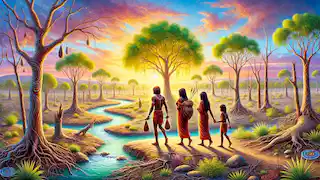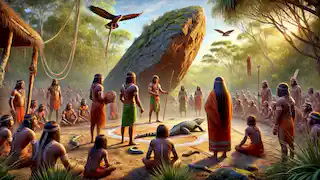The Epic of Djanggawul
Reading time: 10 min

About this story: The Epic of Djanggawul is a Myth from Australia set in the Ancient This Descriptive tale explores themes of Nature and is suitable for All Ages. It offers Moral insights. A creation myth from Australia, where divine siblings shape the world and confront ancient spirits.
Introduction
The Epic of Djanggawul is a foundational myth of the Yolngu people of northeastern Arnhem Land in Australia. It is a creation story, chronicling the journey of the Djanggawul siblings who brought life, culture, and law to the land. The three main characters—two sisters and their brother—are powerful ancestral beings whose actions shaped the landscape, bestowed knowledge, and set in place rituals that the Yolngu people still follow today.
Their journey is a tale of creation, transformation, and the imposition of order in a chaotic world. As we explore this epic, we will delve into the deep symbolism embedded in the Yolngu culture and understand how their connection to the land, the sea, and the sky has shaped their identity. This story is a reflection of the sacred relationship between humans and nature, filled with mystery and spiritual resonance.
The Arrival of the Djanggawul
Long ago, in the time before time, when the world was still raw and unformed, the Djanggawul siblings set out on a sacred journey from their ancestral land of Baralku. Baralku was a distant island beyond the horizon, the place where spirits reside after death, and from which all life originates. The three Djanggawul—two sisters and one brother—were sent by the ancestral spirits to shape the land and bring life to the world.
The eldest of the siblings, Djanggawul the brother, was a powerful figure, tall and strong, with knowledge of the ancient laws of creation. He carried with him the sacred dilly bags, which held the essence of life, the power to bring fertility to the land. His sisters, Djanggawul and Mulawa, were equally vital to the journey. They were not just companions but creators in their own right, with their own sacred roles to play. Mulawa, the younger sister, was the keeper of ritual knowledge, while Djanggawul, the elder sister, held the power of regeneration and transformation.
As the siblings approached the shores of Australia, their canoe sliced through the waves, leaving a shimmering path behind them. The land they came upon was vast and empty, a desolate stretch of sand and rock. But the Djanggawul knew that this was where they would begin their work of creation.
With each step they took upon the land, their presence transformed the barren landscape. They walked, and where their feet touched the earth, grass began to grow, rivers began to flow, and trees sprang up to shade the land. The Djanggawul carried within them the essence of life, and they scattered it like seeds as they traveled.

The Birth of the People
As they journeyed further inland, the Djanggawul began to shape the land in more specific ways. The brother took his dilly bags and opened them, releasing the sacred contents inside. From these bags came the first Yolngu people, who spread out across the land. They were the ancestors of all the clans, and each group was given a specific role and territory by the Djanggawul.
The clans were taught how to live in harmony with the land and each other. Djanggawul, the elder sister, showed the people how to gather food, plant crops, and fish from the abundant rivers and seas. She taught them the sacred laws that would guide their lives, laws that connected them to the spirits of the land and their ancestors. Her younger sister, Mulawa, initiated the women into the sacred rituals of birth and life, passing down the knowledge of motherhood and nurturing.
Meanwhile, Djanggawul, the brother, established the foundations of governance and law. He set down the rules that would govern the clans, ensuring that they lived in balance with the natural world. Under his guidance, the Yolngu people flourished, building strong communities and deep spiritual connections to the land.
But the Djanggawul’s work was far from over. They still needed to fill the land with sacred places—places where the spirits could reside, where ceremonies could be held, and where the people could connect with their ancestors.
The Creation of Sacred Sites
As the Djanggawul continued their journey, they began to create the sacred sites that would dot the Yolngu landscape for generations to come. Each site was imbued with powerful spiritual energy, connected to the ancestral beings who had shaped the land. These places were not just geographical landmarks but portals to the spirit world.
One of the most important sites the Djanggawul created was the Djirri-djirri rock, a massive boulder that rose from the earth like a sentinel. It was here that the Djanggawul performed one of their most important ceremonies—the creation of the clans. Djanggawul, the brother, called forth the ancestors of each clan, giving them a totem and a sacred duty. Some were given the power of the crocodile, others the wisdom of the snake, and still others the strength of the eagle.
Each clan was tied to a specific animal and given responsibility over a particular part of the land. These totems were more than just symbols; they were the living embodiment of the clans’ connection to the land and the spirits. The Djanggawul instructed the people on how to care for their totems, how to honor them in ceremony, and how to live in balance with the natural world.
Mulawa, the younger sister, also created sacred sites dedicated to women’s rituals. She placed large stones in a circle, representing the cycle of life and the seasons. Here, the women of the Yolngu people would gather for ceremonies marking birth, puberty, and motherhood. These ceremonies were vital for the continuation of life and the passing down of knowledge from one generation to the next.

Conflict with the Spirit Beings
Though the Djanggawul had brought life and order to the land, their journey was not without its challenges. The land was not entirely empty when they arrived. Spirit beings, ancient and powerful, already roamed the landscape, creatures of immense strength and cunning. These spirits were wild and untamed, unlike the Djanggawul, who sought to bring order and structure to the world.
One of these spirit beings was the dreaded Yurlunggur, a giant serpent who lived in the depths of the earth and waters. Yurlunggur resented the arrival of the Djanggawul and their attempts to impose order upon the land. He believed that the land belonged to the spirits alone and that the Yolngu people had no place in this world.
The Djanggawul siblings knew that they would need to confront Yurlunggur if their work was to be completed. Djanggawul, the brother, prepared himself for battle, knowing that the serpent was a formidable opponent. He called upon the ancestral spirits for strength, and with the help of his sisters, he set out to find Yurlunggur’s lair.
The battle between Djanggawul and Yurlunggur was fierce and long. The earth trembled as the two titans clashed, with Yurlunggur’s massive coils wrapping around Djanggawul, trying to crush him. But Djanggawul was strong, and with his sacred weapons, he was able to strike Yurlunggur down. The serpent retreated into the depths of the earth, defeated but not destroyed, and to this day, his presence can still be felt in the deep waters of the land.
After the battle, the Djanggawul knew that they had secured the land for the Yolngu people, but they also understood that the spirits would always be present. They taught the Yolngu how to live in harmony with these beings, respecting their power and giving them offerings in ceremonies to maintain balance.
The Final Departure
Having completed their work, the Djanggawul siblings knew that it was time for them to leave. Their journey had transformed the land, and the Yolngu people were thriving, but the Djanggawul could not stay in this world forever. They were beings of the spirit world, and their place was in Baralku, the land of the ancestors.
Before departing, Djanggawul, the elder sister, gathered the Yolngu people one last time. She reminded them of the laws they had been given, the sacred sites they must protect, and the ceremonies that would keep the land and its people in balance. She also gave them the gift of songlines—songs that told the story of the land, the ancestors, and the Djanggawul’s journey. These songlines would guide the Yolngu people across the land, allowing them to navigate and connect with their sacred sites no matter where they traveled.
Mulawa, the younger sister, left behind the knowledge of women’s ceremonies and the rituals that ensured the continuation of life. She reminded the women of their role as the bearers of new life, the nurturers of the future generations.
Djanggawul, the brother, stood silently for a moment, gazing across the land they had shaped. His heart swelled with pride and sorrow. He knew that the Yolngu people were strong and that they would carry on the work he and his sisters had started. With a final nod, he turned toward the sea, and the three siblings began their journey back to Baralku.

Legacy of the Djanggawul
The departure of the Djanggawul marked the end of the creation era, but their legacy lived on. The Yolngu people continued to live by the laws the siblings had set down, maintaining their deep spiritual connection to the land and the ancestors. Every ceremony, every sacred site, and every songline carried the memory of the Djanggawul’s journey.
Over the centuries, the Yolngu passed down these stories, preserving
the epic of the Djanggawul in their oral traditions. The sacred sites created by the Djanggawul became places of pilgrimage, where the Yolngu would gather for important ceremonies and rituals. The clans continued to honor their totems and fulfill their responsibilities to the land, ensuring that the balance between the human and spirit worlds remained intact.
The Djanggawul’s gift of life, law, and culture was not just for the Yolngu people but for all the beings of the land. The animals, the trees, the rivers, and the mountains were all part of the great web of life that the Djanggawul had woven. The Yolngu people, as stewards of the land, understood their role in this web and worked to protect and preserve it for future generations.
Even today, the Yolngu people tell the story of the Djanggawul’s journey. Their epic is not just a myth but a living history, a reminder of their sacred duty to the land and the ancestors. Through ceremony, song, and storytelling, the legacy of the Djanggawul continues to guide the Yolngu people, ensuring that the spirit of creation remains alive in the world.

Conclusion
The Epic of Djanggawul is a powerful creation story that highlights the deep connection between the Yolngu people and their land. It is a tale of transformation, conflict, and harmony, where the actions of the ancestral beings shaped not only the physical landscape but the spiritual and cultural foundations of the Yolngu people. Through their journey, the Djanggawul siblings brought life to the land, taught the people the sacred laws, and established a lasting legacy that continues to guide the Yolngu to this day.










